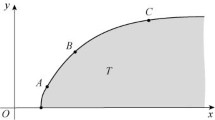Abstract
DEA (data envelopment analysis) is a technique for determining the efficiencyfrontier (the envelope) to the inputs and outputs of a collection of individual corporations or other productive units. DEA is here employed to estimate the intertemporal productive efficiency of U.S. computer manufactures, using financial data brought from earnings statements and balance sheets. The results indicate that a few corporations, including Apple Computer Inc., Compaq Computer Corp., and Seagate Technology were able to stay at the productivity efficiency frontier throughout the time period investigated. But not all successful corporations did; sometimes subefficiency (=disequilibrium) actually goes together with very rapid growth. A new Malmquist type productivity index is calculated for each corporation, measuring shifts of the estimated intertemporal efficiency frontier.
Similar content being viewed by others
References
Hur, W.B. (1989). “Competing Technologies, Increasing Returns, and Lock-In by Historical Events.”The Economic Journal 99, 116–131.
Banker, R.D., A. Charnes, W.W. Cooper, J. Swarts and D. Thomas. (1989). “An Introduction to Data Envelopment Analysis with Some of its Models and Their Uses.”Research in Governmental and Nonprofit Accounting 5, 125–163.
Berlin, F.B. (1987). “Supercomputers: A Policy Opportunity”, in J.R. Kirkland and J.H. Poore (editors),Supercomputers. A Key to U.S. Scientific, Technological, and Industrial Preeminence. Westport, Conn.: Praeger, 57–75.
Caves, D.W., L.R. Christensen, and W.E. Diewert. (1982a). “The Economic Theory of Index Numbers and the Measurement of Input, Output, and Productivity.”Econometrica 50, 1393–1414.
Caves, D.W., L.R. Christensen, and W.E. Diewert. (1982b). “Multilateral Comparisons of Output, Input, and Productivity Using Superlative Index Numbers.”Economic Journal 92, 73–86.
Chakravarthy, B.S. (1986). “Measuring Strategic Performance.”Strategic Management Journal 7, 437–458.
Charnes, A. and W.W. Cooper. (1985). “Preface to Topics in Data Envelopment Analysis.”Annals of Operations Research 2, 59–94.
Charnes, A., W.W. Cooper, N. Eechambadi, B. Golany, D.B. Learner, F.Y. Phillips and J.J. Rousseau. (1994). “A Data Envelopment Analysis of High-Turnover Consumer Products in Competitive Markets,” inData Envelopment Analysis: Theory, Methodology, and Application, ed. by A. Charnes, W.W. Cooper, A.Y. Lewin, and L.M. Seiford. Westport, Conn.: The IC2 Management and Management Science Series, Quorum Books.
Charnes, A., W.W. Cooper, D.B. Sun and Z.M. Huang. (1990). “Polyhedral Cone-Ratio DEA Models With an Illustrative Application to Large Commerical Banks.”Journal of Econometrics 46, 72–91.
Charnes, A., W.W. Cooper, Z.M. Huang and D.B. Sun. (1994). “DEA Cone-ratio Approaches for Use in Developing Decision Support Systems to Monitor Performance in a Collection of Banks,” inData Envelopment Analysis: Theory, Methodology, and Application, ed. by A. Charnes, W.W. Cooper, A.Y. Lewin, and L.M. Seiford. Westport, Conn.: The IC2 Management and Management Science Series, Quorum Books.
Charnes, A., W.W. Cooper and E. Rhodes. (1978). “Measuring the Efficiency of Decision Making Units.”European Journal of Operational Research 2, 429–444.
Cole, R., Y.C. Chen, J.A. Barguin-Stolleman, E. Dulberger, N. Helvacian and J.H. Hodge. (1986). “Quality-adjusted price indexes for computer processors and selected peripheral equipment.”Survey of Current Business 66, 41–50.
Council on Competitiveness. (1993).Competitiveness Index, Washington D.C.: Council on Competitiveness, annual publications.
R. Dorfman, P.A. Samuelson, and R.M. Solow. (1958).Linear Programming and Economic Analysis. New York: McGraw-Hill.
Fare, R., S. Grosskopf, B. Lindgren, and P. Roos. (1992). “Productivity Changes in Swedish Pharmacies 1980–1989: A Non-Parametric Malmquist Approach.”Journal of Productivity Analysis 3, 261–283.
Fare, R., S. Grosskopf, B. Lindgren, and P. Roos. (1994). “Productivity Developments in Swedish Hospitals: A Malmqvist Output Index Approach,” inData Envelopment Analysis: Theory, Methodology, and Application, A. Charnes, W.W. Cooper, A.Y. Lewin, and L.M. Seiford (eds.) Westport, Conn.: The IC2 Management and Management Science Series, Quorum Books.
Forsund, F. and L. Hjalmarsson. (1987)Analyses of Industrial Structure: A Putty-Clay Approach. Stockholm: Almqvist & Wiksell.
Golany, B., D.B. Learner, F.Y. Phillips and J.J. Rousseau. (1990a). “Efficiency and Effectiveness in Marketing Management,” in B.-H. Ahn (editor),Asian-Pacific Operations Research: APORS'88. Elsevier: Science Publishers B.V.
Golany, B., D.B. Learner, F.Y. Phillips and J.J. Rousseau. (1990b). “Managing Service Productivity: The Data Envelopment Analysis Perspective.”Computers, Environment and Urban Systems 14, 89–102.
Golany, B. and S. Thore. (1993). “On the Treatment of Negative Output Values in DEA.” The University of Texas at Austin: IC2 Institute Working Papers.
Hall, M. and J. Barry. (1990).Sunburst: The Ascent of SUN Microsystems. Chicago: Contemporary Books Inc.
Kenney, C.C. (1992).Riding the Runaway Horse: the Rise and Decline of Wang Laboratories. New York: Little, Brown.
Koopmas, Tj.C. (1957).Three Essays on the State of Economic Science. New York: McGraw-Hill.
Mansfield, E. (1987). “The Impact of Technological Innovation on Economic Growth and Employment,” inTechnological Innovation and Economic Growth, P.A. Abetti, C.W. LeMaistre, R.W. Smilor and W.A. Wallace (eds.). The University of Texas at Austin: IC2 Institute.
Nicolis, G. and I. Prigogine. (1977)Self-Organization in Nonequilibrium Systems: From Dissipative Structures to Order Through Fluctuations. New York: Wiley 1977.
Reich, R. B. (1991).The Work of Nations: Preparing Ourselves for 21 st Century Capitalism. New York: Knopf.
Seiford, L. and R.M. Thrall. (1990). “Recent Developments in DEA: The Mathematical Programming Approach to Frontier Analysis.”Journal of Econometrics 46, 7–38.
Sethi, S.P. and G.L. Thompson. (1981).Optimal Control Theory: Applications to Management Science. Boston: Martinus Nijhoff Publishing.
Smith, P. (1990). “Data Envelopment Analysis Applied to Financial Statements.”Omega International Journal of Management Science 18, 131–138.
Terleckyj, N. (1974)Effects of R&D on the Productivity Growth of Industries. Washington, D.C.: National Planning Association.
Triplett, J.E. (1986). “The Economic Interpretation of Hedonic Methods.”Survey of Current Business 66, 36–40.
Tulkens, H. and P. Vanden Eeckaut (1991), “Malmquist Indices of Productivity with FDH vs. DEA Technologies.” Presented at a Conference on Current Issues in Productivity, Graduate School of Management, Rutgers State University of New Jersey.
Yue, P. (1991).Competition Between U.S. and Japanese Electronics Companies. The University of Texas at Austin: IC2 Institute.
Author information
Authors and Affiliations
Rights and permissions
About this article
Cite this article
Thore, S., Kozmetsky, G. & Phillips, F. DEA of financial statements data: The U.S. computer industry. J Prod Anal 5, 229–248 (1994). https://doi.org/10.1007/BF01073909
Issue Date:
DOI: https://doi.org/10.1007/BF01073909




